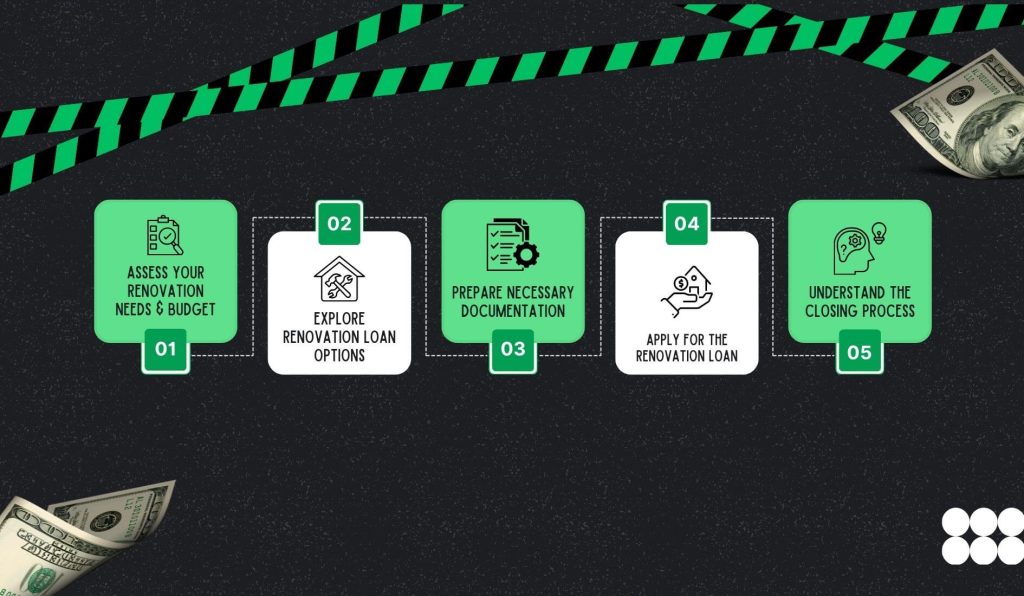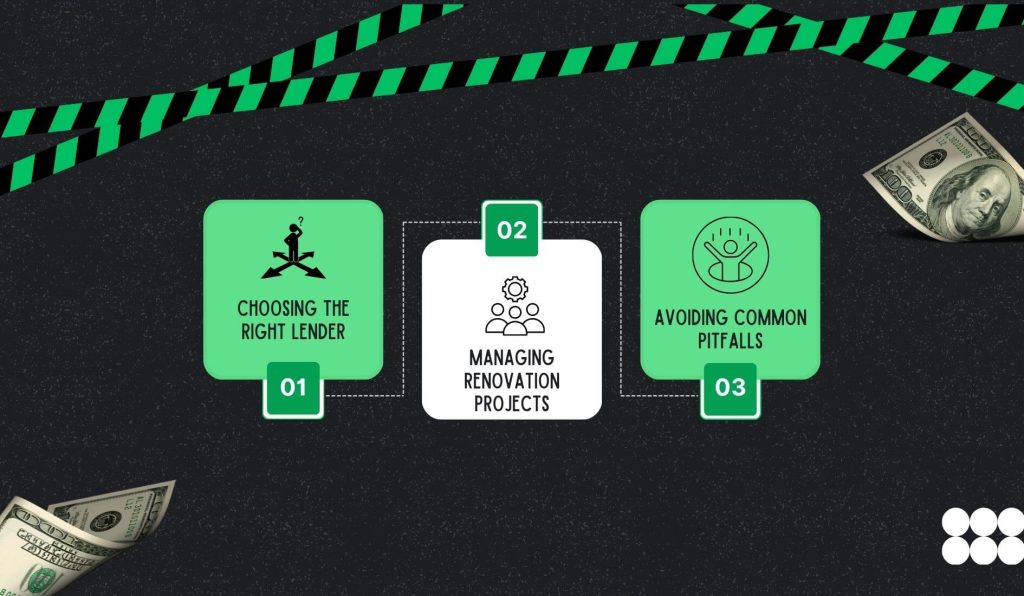- Traditional vs. Renovation Home Loans
- Step 1 – Assess Your Renovation Needs and Budget
- 1. Project Scope
- 2. Planning the Budget
- 3. Consulting a Professional
- Step 2 – Explore Renovation Loan Options
- Types of Loans
- Eligibility Criteria
- Loan Terms
- Step 3 – Prepare Necessary Documentation
- 1. Financial Documents
- 2. Project Plans
- 3. Property Information
- Step 4 – Apply for the Renovation Loan
- Application Process
- Loan Estimate
- Approval Timeline
- Step 5 – Understand the Closing Process
- Closing Costs
- Disbursement of Funds
- Post-Closing Requirements
- Expert Tips for a Smooth Renovation Loan Experience
- 1. Choosing the Right Lender
- 2. Managing Renovation Projects
- 3. Avoiding Common Pitfalls
- Comparison of Popular Renovation Loan Options
- Frequently Asked Questions (FAQs)
How to Apply for a Renovation Home Loan: Step-by-Step Guide

Are you staring at that cracked kitchen tile again? Maybe it’s the bathroom that’s been begging for a facelift since 2012. Either way, you are thinking of renovation. Well, they cost a lot of money. That’s where a renovation home loan comes in.
Therefore, read on to get a better idea of how to apply for a renovation home loan.
Traditional vs. Renovation Home Loans

Unlike traditional home loans that help you buy a house, renovation loans are designed to help you fix the one you already have. Also, it enables you to fix the one you are about to purchase and want to upgrade.
Programs like the FHA 203(k) loan enable borrowers to finance both home purchase and renovation. Moreover, these loans can be a smart way to increase property value without draining your savings.
Hence, it shows that if your home needs work and your wallet needs help, this might be the way.
Step 1 – Assess Your Renovation Needs and Budget
If you want to assess your renovation needs and budget, plan for the following:
1. Project Scope
Do you want a full-blown remodel or merely a new backsplash? Then, you have to know what you are getting into. Also, write it down or sketch it out. In fact, make a Pinterest board (if that’s your thing). Basically, the better you plan, the smoother the loan process.
2. Planning the Budget
This is the part that none of us like: money. At this stage, you will have to predict costs for materials, labor, permits, and other requirements. It is important always to add a buffer.
3. Consulting a Professional
Start talking to contractors (also get multiple quotes). Moreover, ask them questions and get timelines. Furthermore, make sure they are licensed and insured. You don’t want surprises halfway through demo day.
Step 2 – Explore Renovation Loan Options
This part is like shopping for clothing. Although you have many options, not all of them will fit. The following are the factors you must take into account to explore renovation home loans:
Types of Loans
While looking for a renovation home loan, go for the following:
- FHA 203(k) Loan: Backed by the government. Also, it is great for fixer-uppers. Moreover, it covers both purchase and renovation.
- Fannie Mae HomeStyle Renovation Loan: It is more flexible and can be used for luxury upgrades, too.
- Personal Home Improvement Loans: It is unsecured and come with faster approval. However, it usually has higher interest rates.
Eligibility Criteria
To get a renovation home loan, you will need decent credit (Usually 620 or higher) and a steady income. In addition, the property has to meet certain conditions. This is because some loans will not cover homes in poor shape.
Loan Terms
In most cases, interest rates vary. FHA loans tend to have lower interest rates but come with mortgage insurance. Also, repayment periods can stretch from 5 to 30 years. Apart from that, loan amounts depend on your income, credit, and project scope.
Step 3 – Prepare Necessary Documentation
For proper paperwork, ensure you have the following:
1. Financial Documents
Lenders want to see your pay stubs, tax returns, and bank statements. This is the whole financial picture. Hence, be honest and thorough.
2. Project Plans
You will need detailed renovation plans. Hence, focus on the following:
- Contractor bids
- Timelines
- Material lists
Basically, prove you know what you are doing (or that your contractor does).
3. Property Information
You will have to show the following information about your property:
- Appraisal reports
- Insurance documents
- Title deeds.
In fact, you have to show anything that shows the home’s current value and condition.
Step 4 – Apply for the Renovation Loan
If you want to apply for a renovation loan, you have to focus on the following:
Application Process
You can do this online or in person. Some lenders have awesome apps, while others lack much convenience. Either way, fill out the forms, upload your docs, and hit submit.
Loan Estimate
After you apply for a renovation home loan, you will get a loan estimate within a few days. It breaks down interest rates, monthly payments, and closing costs. Make sure to read it (Twice). Also, ask questions if you do not understand something.
Approval Timeline
The timeline for approval could be a week or even a month. Basically, it depends on the lender, your paperwork, and the complexity of the renovation. Hence, patience is key.
Step 5 – Understand the Closing Process
The following are the major aspects of the loan closing process:
Closing Costs
At this stage, expect the following fees:
- Origination fees
- Appraisal fees
- Title insurance.
In fact, the total cost could be 2–5% of the loan amount. Hence, make sure to budget for it.
Disbursement of Funds
Funds aren’t handed over in one big chunk. Usually, the financial institution releases them in stages (called “draws”) as the work progresses. Also, your contractor receives payment after inspections.
Post-Closing Requirements
At this stage, you must submit progress reports, photos, and updated timelines. Although some lenders will not ask for it, others might track everything.
Expert Tips for a Smooth Renovation Loan Experience

If you want a smooth renovation home loan experience, do the following:
1. Choosing the Right Lender
Go with someone who has experience with renovation loans. Well, not all banks have experience with renovation loans. Also, ask for recommendations and read reviews. Don’t just chase the lowest rate.
2. Managing Renovation Projects
Make sure to stay involved. Hence, do the following:
- Visit the site
- Talk to your contractor
- Keep receipts
- Track expenses.
Since it is your home, you have to own the process.
3. Avoiding Common Pitfalls
Don’t underestimate costs or skip permits. Also, do not hire your cousin who “used to do drywall.” Moreover, do not make the mistake of paying your contractors upfront.
Comparison of Popular Renovation Loan Options
| Feature | FHA 203(k) Loan | Fannie Mae HomeStyle | Personal Home Improvement Loan |
|---|---|---|---|
| Backed by the Government | Yes | No | No |
| Credit Score Requirement | 620+ | 620+ | 660+ |
| Max Loan Amount | Based on FHA limits | Based on income/property | Varies by lender |
| Use for Luxury Upgrades | Limited | Yes | Yes |
| DIY Allowed | No | Sometimes | Yes |
| Disbursement Method | In stages | In stages | Lump sum |
| Interest Rates | Lower and comes with insurance | Competitive | Higher |
To be honest, applying for a renovation home loan is not an easy thing to do. However, it is doable if you have the right approach. If you have a vision for your home, it is worth the effort.
Hence, you must plan to move step by step. Moreover, ask questions and stay organized. Also, you must realize that the goal isn’t merely to get the loan but to build the home you actually want to live in.
Frequently Asked Questions (FAQs)
The following are some of the most common questions you will come across regarding a renovation home loan:
To qualify for a renovation home loan, you must have the following:
• Good credit
• Stable income
• A solid renovation plan
In some cases, you will be able to use a renovation home loan for your DIY projects. Although some lenders allow it, most of them prefer licensed contractors.
The timeline for a renovation home loan approval ranges from a week to a month. Basically, it depends on the complexity of the loan.










